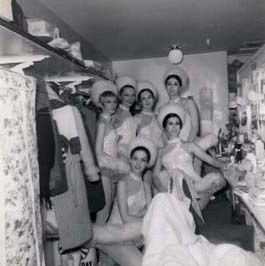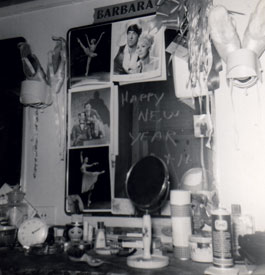

Julia Savoye Coletta
Radio City Corps de Ballet dancer 1949-1950
Unlike many ballet companies, the dancers of the Radio City Corps de Ballet often began their careers as dancers when they were young women, not girls. They came to New York City after High School rather than in their early teens, all with a serious interest in dance. To hone their skills, they would study intensely for a year or two with one of New York's many suburb ballet teachers before auditioning for the Music Hall.
Dancing for America's only permanent resident ballet company was not an easy task. For four weeks, every day of the week, four shows per day, rehearsal every day, the seemingly delicate and ethereal dancers of the Radio City Corps de Ballet proved that they were made of steel, not tulle. On the fifth week, their week off, it was not unusual to be called in after four or five days to begin rehearsal for a new show or to substitute for a sick or injured dancer.
This kind of rigid, non-stop performance schedule is unusual for dance companies. Radio City had no ballet "season," they operated 365 days of the year and there was a ballet for every show. While the performance schedule was grueling, it provided the dancers with a steady paycheck, an almost unheard of luxury for dancers.
By the 1960s, however, working conditions and the attitudes of the dancers had changed at Radio City. The dancers belonged to the Associated Guild of Variety Artists (AGVA), a union that helped to restrain the number of hours the dancers worked.
As one dancer from 1966 stated:
"In the old days there was a different type of dancer here. The girls were strong, could do anything and they stayed around for six or seven years. They settled in, like secretaries. They didn't take class and they weren't interested in advancement. Now the girls are younger. There's a larger variety of types. They take class and they're ambitious. Of those who go off to summer stock, only a few return in the fall."
1967 began a series of srtikes that, along with other financial difficulties, forced the management of Radio City Music Hall to cut the Corps de Ballet from its line-up in 1972.
From the collection of Barbara Klein c.1967
"...and yet the major attraction at the Radio City Music Hall is not really the mechanical magic of its stage--not even the fact that its films are first-run--not even its sixty-piece symphony orchestra and its giant organ--or, for that matter, its twenty-four man glee club. It is a row of thirty-six seemingly identical females called the Rockettes plus three dozen gentler, less machine-like girls called the Corps de Ballet."
Dance Magazine
1956

From the collection of Barbara Klein c.1967